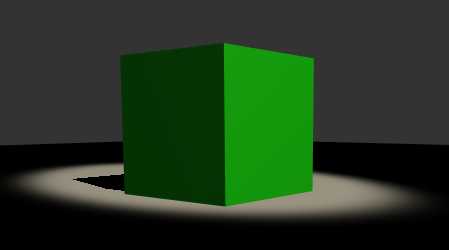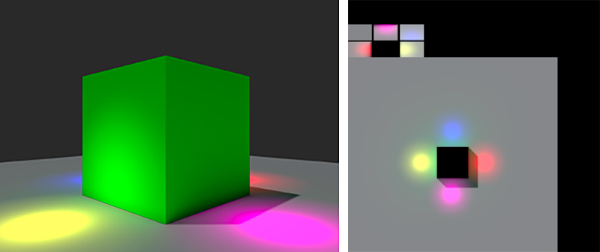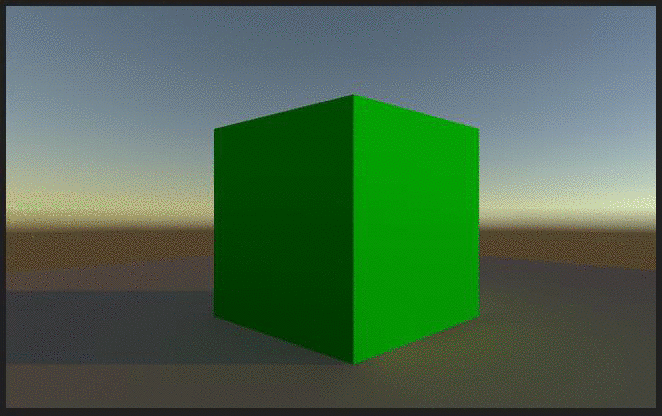Lighting overview
In order to calculate the shading of a 3D objectA 3D GameObject such as a cube, terrain or ragdoll. More info
See in Glossary, Unity needs to know the intensity, direction and color of the light that falls on it.
These properties are provided by Light objects in the scene. Different types of light emit their assigned color in different ways; some lights may diminish with distance from the source, and have different rules about the angle of light received from the source. The different types of light source available in Unity are detailed in Types of light.
Unity can calculate complex, advanced lighting effects in various different ways, each suited to different use cases.
Choosing a lighting technique
Broadly speaking, lighting in Unity can be considered as either ‘realtime’ or ‘precomputed’ in some way and both techniques can be used in combination to create immersive sceneA Scene contains the environments and menus of your game. Think of each unique Scene file as a unique level. In each Scene, you place your environments, obstacles, and decorations, essentially designing and building your game in pieces. More info
See in Glossary lighting.
In this section we will give a brief overview of what opportunities the different techniques offer, their relative advantages and individual performance characteristics.
Realtime lighting
By default, lights in Unity - directional, spot and point, are realtime. This means that they contribute direct light to the scene and update every frame. As lights and GameObjectsThe fundamental object in Unity scenes, which can represent characters, props, scenery, cameras, waypoints, and more. A GameObject’s functionality is defined by the Components attached to it. More info
See in Glossary are moved within the scene, lighting will be updated immediately. This can be observed in both the scene and game views.

Realtime lighting is the most basic way of lighting objects within the scene and is useful for illuminating characters or other movable geometry.
Unfortunately, the light rays from Unity’s realtime lights do not bounce when they are used by themselves. In order to create more realistic scenes using techniques such as global illumination we need to enable Unity’s precomputed lighting solutions.
Baked lightmaps
Unity can calculate complex static lighting effects (using a technique called global illumination, or GI) and store them in a reference texture map called a lightmapA pre-rendered texture that contains the effects of light sources on static objects in the scene. Lightmaps are overlaid on top of scene geometry to create the effect of lighting. More info
See in Glossary. This calculation process is referred to as baking.
When baking a lightmap, the effects of light sources on static objects in the scene are calculated and the results are written to textures which are overlaid on top of scene geometry to create the effect of lighting.

These lightmaps can include both the direct light which strikes a surface and also the indirect light that bounces from other objects or surfaces within the scene. This lighting texture can be used together with surface information like color (albedo) and relief (normals) by the ShaderA small script that contains the mathematical calculations and algorithms for calculating the Color of each pixel rendered, based on the lighting input and the Material configuration. More info
See in Glossary associated with an object’s material.
With baked lighting, these lightmaps cannot change during gameplay and so are referred to as ‘static’. Realtime lights can be overlaid and used additively on top of a lightmapped scene but cannot interactively change the lightmaps themselves.
With this approach, we trade the ability to move our lights at gameplay for a potential increase in performance, suiting less powerful hardware such as mobile platforms.
See the Lighting window reference and Using precomputed lighting for more information.
Precomputed realtime global illumination
Whilst static lightmaps are unable to react to changes in lighting conditions within the scene, precomputed realtime GI does offer us a technique for updating complex scene lighting interactively.
With this approach it is possible to create lit environments featuring rich global illumination with bounced light which responds, in realtime, to lighting changes. A good example of this would be a time of day system - where the position and color of the light source changes over time. With traditional baked lighting, this is not possible.

In order to deliver these effects at playable framerates, we need to shift some of the lengthy number-crunching from being a realtime process to one which is precomputed.
Precomputing shifts the burden of calculating complex light behaviour from something that happens during gameplay, to something which can be calculated when time is no longer so critical. We refer to this as an ‘offline’ process.
For further information, please see the lighting and rendering tutorial.
Benefits and costs
Although it is possible to simultaneously use Baked GI lighting and Precomputed Realtime GI, be wary that the performance cost of renderingThe process of drawing graphics to the screen (or to a render texture). By default, the main camera in Unity renders its view to the screen. More info
See in Glossary both systems simultaneously is exactly the sum of them both. Not only do we have to store both sets of lightmaps in video memory, but we also pay the processing cost of decoding both in shaders.
The cases in which you may wish to choose one lighting method over another depend on the nature of your project and the performance capabilities of your intended hardware. For example, on mobile where video memory and processing power is more limited, it is likely that a Baked GI lighting approach would be more performant. On standalone computers with dedicated graphics hardware, or recent games consoles, it is quite possible to use Precomputed Realtime GI or even to use both systems simultaneously.
The decision on which approach to take will have to be evaluated based on the nature of your particular project and desired target platform. Remember that when targeting a range of different hardware, that often it is the least performant which will determine which approach is needed.
See also: Light Troubleshooting and Performance
Did you find this page useful? Please give it a rating: